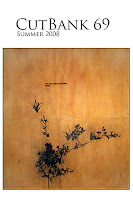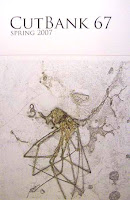
Futurepoem Books
Reviewed by Heather Sweeney
The book remains dangerously fragile--even more so after all my mark-making, gluing, soaking. The binding has been pushed almost beyond its limits. So I was pushing against the limits of "the book" and the limits of what is held in the body as language…
—JILL MAGI
…dwelling and travel are not distinct
—MEI-MEI BERSSENBRUGGE
…dwelling and travel are not distinct
—MEI-MEI BERSSENBRUGGE
Magi boldly tests the limits of the book’s form in Threads which simultaneously binds and frays at every turn. In 1997, Magi ventured into Estonia alone and unarmed with the language. It is here, within this “book-art project,” that she aspires to desilence and uncensor the history of a country. The poet attempts to recover and resuscitate father, an Estonian refugee of WWII in a forest of multi-layered sounds and landscapes. Woven with with maps, letters, biographies, photographs, dress patterns and song, Threads both tears and sews. Unraveling a series of experiential blueprints, the book ultimately investigates self in relation to lineage, and its fluctuating degrees of disintegration and salvagement.
Similar to Eleni Sikelianos’s endeavor in The Book of Jon, Magi navigates through the various tales of her father’s life to inhabit his physical, emotional and intellectual spaces. Upon her arrival in Estonia, Magi pursues an imagined connection:
Needing more time to arrive, I sit on a bench between ferry terminal and city gate, imagining that my father’s history is visible on my face. An uncertain expression. Perhaps sadness or certain Estonian features such as hair color or the eyes, though in any other context, I do not believe in this (9).
Touching an illegible distance, a memory of a face becomes a map. Gaps in translations and history are illuminated.
Without a table of contents, the reader is immediately thrown into the deep end of an evolving Estonia, a place of supposed regentrification: “The attachment of cell phones to the belt and new umbrellas over empty café tables is read as progress” as “museum labels peel away…” (1). The poet appears confused among a rubble of weeds, burning garbage, bullet holes, electrical wires and cement apartment buildings. And it is this confusion, a self-reported “vertigo,” that mirrors the disjointed nature of the book. Preservation is pieced. Reconstruction is messy. Magi craftily exposes these processes through a vividly collaged portrait.
Documenting the fleeting essence of her search, Magi reconstructs an undeniable impermanence. She is “sketching a breath a fingerprint dissolves” (108) but there is also an acute awareness of something “to find out. A view called history. Or to enter” (44). The poet is grasping and gazing through the gaps of her father’s sparsely recorded life: “(Dear Dad, if you can even vaguely translate--)” (112). She seeks to hold onto any remnants of her journey: “I collect stains and bits /of leaves” (119). What is left: ephemeral souvenirs. Although ephemerality and loss hover over the book like a “cloud of blackbirds,” the essence is what remains as the “grain of the original is ascertained” (8).
The reader is moved from a familiar, autonomous place where “map of comfort was--/pillow of no tradition” (48) to an atmosphere “of generative tensions” (50). Revealing doubt and mispronunciations, Magi’s threads mesh to form a unique texture of sounds and language; as “each day falls off into unspeech” (38) we lean in to listen to the “stuttering infrastructure” and “flexible word order” (45). Lines are infused with uncertain translation. Her efforts are textured with a certain struggle. Threads of speech are revealed as “flashcard fossils” (4). Magi reports to her father: “Inside my body your language is growing” (124).
We tend to think of ourselves as autonomous creatures, and this is reified by our culture of duality and compartmentalization. Yet, the acknowledgement of and quest for connections may shift and transform perceptions of self, moving us from “the position of the single body versus a whole family “(52). Our pasts are fragile structures and one must often take a journey far outside, beyond our self-imposed limits, in order to begin to understand them. Magi inspires us to do so with strength and without hesitation so that we also may come to know our own “inherited map.”
**
Jill Magi is a writer and artist living in Brooklyn, New York. She is the author of the chapbook Cadastral Map, published in 2005 by Portable Press at Yo-Yo Labs, as well as several self-published and personally distributed small, handmade books. Her poetry, prose, and visual work has been published in HOW2, The Brooklyn Rail, Jacket, The New Review of Literature, Aufgabe, Chain, and Pierogi Press, and exhibited at the Brooklyn Arts Council Gallery and the Brooklyn Waterfront Artists Coalition. A 2006-07 writer-in-residence with the Lower Manhattan Cultural Council, she also teaches at The City College Center for Worker Education and runs Sona Books, a small press dedicated to publishing risky, quiet, project-driven works in chapbook form.
**
Heather Sweeney lives in San Diego where she works as a design consultant and teaches yoga.



